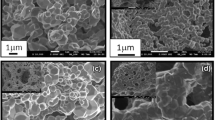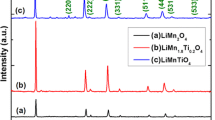Abstract
A study on the structural and electrochemical properties of LiCr0.2Mn1.8O4 and LiV0.2Cr0.2Mn1.6O4 cathodes has been made with a view to understand the effect of mono- (Cr) and bication (Cr and V) substitution on LiMn2O4 spinel individually. Citric acid assisted modified sol–gel method has been followed to synthesize a series of LiMn2O4, LiCr0.2Mn1.8O4, and LiV0.2Cr0.2Mn1.6O4 cathodes, and the corresponding lattice structure, surface morphology, and site occupancy of lithium in the spinel matrix are acknowledged using X-ray diffraction, scanning electron microscopy, and magic angle spinning 7Li nuclear magnetic resonance results. The site occupancy of Cr3+ in the 16d octahedral and that of V5+ in the 16d octahedral and 8a tetrahedral positions are understood. Electrochemical cycling studies of LiCr0.2Mn1.8O4 cathode demonstrate an enhanced structural stability and better capacity retention (94%) resulting from the Cr3+ dopant-induced co-valency of Li-O-Mn bond. On the other hand, simultaneous substitution of Cr and V in LiV0.2Cr0.2Mn1.6O4 has failed to improve the electrochemical properties of native LiMn2O4 spinel cathode, mainly due to vanadium-driven cation mixing and the reduced lithium diffusion kinetics. Among the candidates chosen for the study, LiCr0.2Mn1.8O4 qualifies itself as a better cathode for rechargeable lithium battery applications.







Similar content being viewed by others
References
Thackeray MM, David WIF, Bruce PG, Goodenough JB (1983) Mater Res Bull 18:461–472
Lee YJ, Wang F, Grey CP (1998) J Am Chem Soc 120:2601–12613
Ramana CV, Massot M, Julien CM (2005) Surf Interface Anal 37:412–416
Grey CP, Dupre N (2004) Chem Rev 104:4493–4512
Tarascon JM, Armand M (2001) Nature 414:359–367
Ohzuku T, Makimura Y (2001) Chem Lett 30:744
Nagaura T, Tozawa K (1990) Prog Batteries Sol Cells 9:209
Tucker MC, Reimer JA, Cairns EJ (2002) J Electrochem Soc 149:A574–A585
Fu YP, Su YH, Lin CH (2004) Solid State Ionics 166:137–146
Tucker MC, Kroeck L, Reimer JA, Cairns EJ (2002) J Electrochem Soc 149:A1409–A1413
Sigala C, Guyomard D, Verbaere A, Piffard Y, Tournoux M (1995) Solid State Ionics 81:167–170
Hu Y, Liu YH (2005) Mater Chem Phys 90:255–261
Jayaprakash N, Kalaiselvi N, Periasamy P (2007) Nanotechnology 19:025603–025608
Jayaprakash N, Sathiyanarayanan K, Kalaiselvi N (2007) Electrochim Acta 52:2453–2460
Kalaiselvi N, Doh CH, Park CW, Moon SI, Yun MS (2004) Electrochem Commun 6:1110–1113
Rojas RM, Petrov K, Avdeev G, Amarilla JM, Pascual L, Rojo JM (2007) J Therm Anal Calorim 90:67–72
Morgan KR, Collier S, Burns G, Ooi K (1994) J Chem Soc Chem Commun 2:1719–1720
Treuil N, Labruge’re C, Menetrier M, Portier J, Campet G, Deshayes A, Frison JC, Hwang SJ, Song SW, Choy JH (1999) J Phys Chem B 103:2100–2106
Jayaprakash N, Kalaiselvi N, Gangulibabu, Bhuvaneswari (2010) Electrochimica Acta (in press)
Takahashi M, Tobishima SI, Takei K, Sakurai Y (2002) Solid State Ionics 148:283–289
Striebel KA, Deng CZ, Wen SJ, Cairns EJ (1996) J Electrochem Soc 143:1821–1827
Kalyani P, Kalaiselvi N, Renganathan NG (2005) Mater Chem Phys 90:196–202
Tang SB, Lai MO, Lu L (2006) Electrochim Acta 52:1161–1168
He BL, Zhou WJ, Liang YY, Bao SJ, Li HL (2006) J Colloid Interfac Sci 300:633–639
Tang SB, Lai MO, Lu L (2007) J Power Sources 164:372–378
Sigala C, Verbaere A, Mansot JL, Guyomard D, Piffard Y, Tournoux M (1997) J Solid State Chem 132:372–381
Acknowledgements
The authors are thankful to the Department of Science and Technology (DST), India for the financial support to carry out this work.
Author information
Authors and Affiliations
Corresponding author
Rights and permissions
About this article
Cite this article
Jayaprakash, N., Kalaiselvi, N., Gangulibabu et al. Effect of mono- (Cr) and bication (Cr, V) substitution on LiMn2O4 spinel cathodes. J Solid State Electrochem 15, 1243–1251 (2011). https://doi.org/10.1007/s10008-010-1194-6
Received:
Revised:
Accepted:
Published:
Issue Date:
DOI: https://doi.org/10.1007/s10008-010-1194-6




